Understanding the Significance of Marquise Cut Diamonds
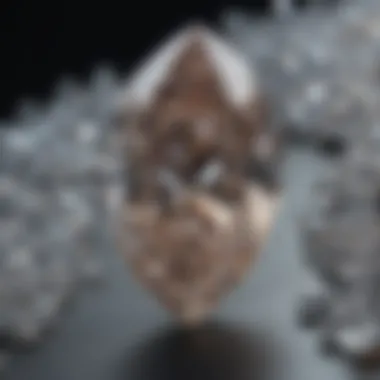
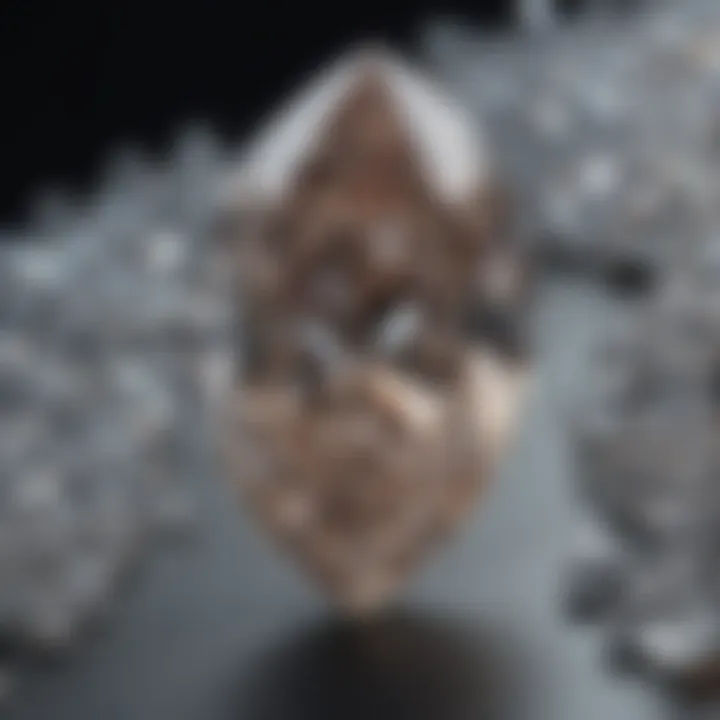
Intro
Marquise cut diamonds have a story to tell, one that weaves through time, culture, and craftsmanship. This unique and elegant cut, with its elongated shape and pointed ends, has captivated the hearts of many, symbolizing luxury and individuality. As we take a closer look at the allure and significance of marquise cut diamonds, it becomes apparent that their value transcends mere carats. From their historical roots to their current market presence, understanding these gems unveils a partnership of art and nature.
Gemstone Overview
Definition and Characteristics
A marquise cut diamond is characterized by its distinctive shape, resembling a boat, with two pointed ends and curved sides. Typically, this cut is designed to maximize the carat weight of the diamond, creating an impression of size while maintaining an elegant silhouette. The brilliance and fire of a marquise cut can rival other popular shapes, making it a favorite among jewelry designers.
Some noteworthy attributes of marquise cut diamonds include:
- Length-to-Width Ratio: Marquise diamonds are often appreciated for their length, and ideal ratios generally range from 1.75 to 2.25. A longer diamond creates that ultra-slim appearance, which many find appealing.
- Faceting: This cut usually consists of 56 facets, which enhance the stone's brilliance and light reflection.
- Versatility: Marquise cut diamonds are not just for engagement rings; their unique shape makes them suitable for pendants, earrings, and other jewelry forms.
Classification of Gemstones
Diamonds, including marquise cuts, fall under the category of precious gemstones. They are primarily classified based on their cut, clarity, carat weight, and color, known as the "Four Cs." This classification helps assess their quality and market value. Moreover, marquise diamonds can be further categorized based on their origin, which impacts both their historical significance and pricing.
Historical Significance
Ancient Uses and Cultural Importance
The marquise cut is said to date back to the 18th century. It was commissioned by King Louis XV of France to honor the beauty of his mistress, the Marquise de Pompadour. As such, this cut has always been associated with grandeur and royal lineage, imbuing it with a sense of historical weight.
Over time, cultures across the globe have assigned different meanings to diamonds, often viewing them as symbols of strength and invincibility. The marquise cut, with its distinct appeal, has been revered in various cultures, and its value as a symbol of eternal love makes it a popular choice for engagement rings.
Myths and Legends Surrounding Gemstones
Diamonds, marquise or otherwise, are often shrouded in myths and superstitions. Some believe that diamonds possess mystical qualities, serving as a protective talisman. In different folklore traditions, they were impressively thought to bring wealth and prosperity to the wearer. Such stories may elevate the cultural and monetary worth of marquise diamonds, making them coveted treasures.
As we step further into the narrative of marquise cut diamonds, it becomes evident that their unique qualities not only enhance their beauty but also contribute significantly to their value in today’s market.
"The value of a diamond is not merely in its physical attributes, but also in the stories it carries through history and culture."
In the upcoming sections, the discussion will delve deeper into the aesthetic qualities and value considerations of marquise cut diamonds, offering insight for gemstone enthusiasts and collectors alike.
Prelims to Marquise Cut Diamonds
Marquise cut diamonds are not just another option in the world of gemstones; they carry with them a certain allure and charm that can captivate the most discerning collectors and enthusiasts. What makes the marquise cut distinct is its unique shape, which resembles a boat or an elongated oval. This shape isn’t mere happenstance; it’s been crafted over the centuries, appealing to individuals with an eye for elegance and drama.
Understanding the marquise cut is vital for anyone delving into the diamond market. It stands out among traditional diamond cuts, often considered a symbol of sophistication and refinement. The elongated shape of the marquise cut has been known to give the illusion of greater size, a feature that many find appealing when choosing jewelry, especially engagement rings. In the world of gemstones, looks can indeed be deceiving, and the marquise cut exemplifies this perfectly.
Defining the Marquise Cut
The marquise cut, originating from the 18th century, is characterized by its pointed ends and a center that curves gracefully. This specific cut is designed to maximize the diamond's surface area, allowing for more light to enter. The name of the cut is said to be derived from the Marquise of Pompadour, who was favored by King Louis XV of France. Over the years, the marquise cut has evolved but remains a classic choice among diamond cuts.
A key aspect of its definition lies in its proportions, which can vary widely. A well-cut marquise should ideally have a length-to-width ratio between 1.75:1 to 2:1, ensuring that it has that coveted elongated silhouette without appearing too narrow. This balance plays a crucial role in determining the diamond's final aesthetic appeal. The precision involved in crafting a marquise cut requires skilled craftsmanship, as the cut can easily showcase flaws if not executed properly.
Historical Context of the Marquise Cut
The historical journey of the marquise cut diamond is fascinating and notable. It emerged in the 1700s when cutting techniques were relatively nascent. A diamond’s beauty wasn’t just in its color or clarity; the crafting technique was pivotal in enhancing its inherent qualities. The marquise cut was a breakthrough in this regard, as it allowed for more light reflection than many traditional cuts of the time. A marquise diamond, in essence, was like showing off a well-polished sword – sharp, elongated, and undeniably striking.
Through the 19th century, the marquise cut gained popularity, especially among the upper echelons of society. It became synonymous with opulence and was frequently worn by aristocrats. As we moved into the 20th century, the marquise cut found its place in art deco designs, accentuating the geometric patterns that defined the era.
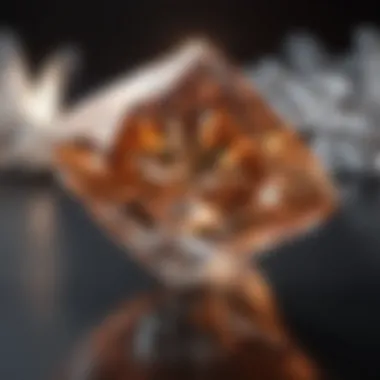
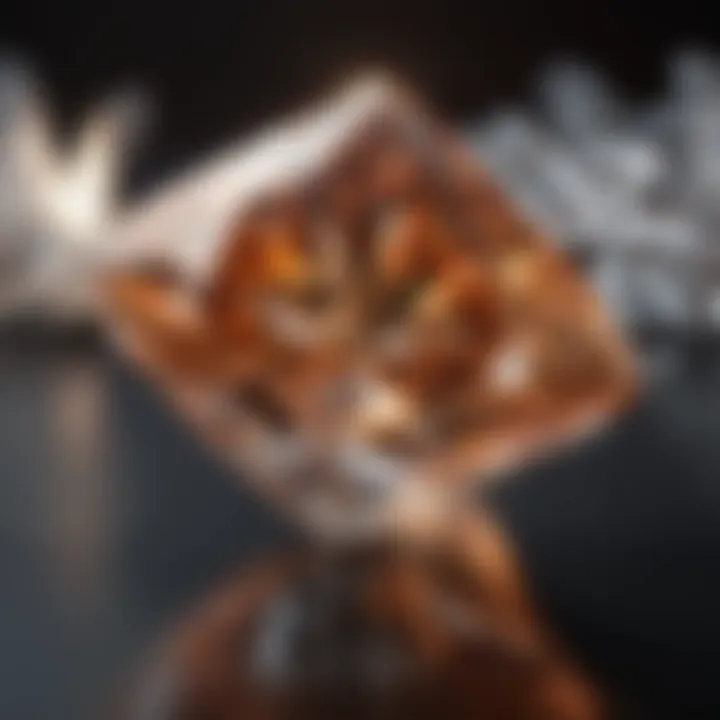
Today, marquise cut diamonds hold a unique spot in modern jewelry. They evoke a sense of nostalgia while embodying timeless elegance. The historical importance of the marquise cut showcases how it has survived the test of time and retained relevance even in an era characterized by constantly shifting trends. During significant moments, they have adorned many a hand or neck, symbolizing love, commitment, or simply an appreciation for beauty.
"The marquise cut is not just about being different; it’s about celebrating the unique essence of beauty in every facet."
In summary, the introduction to marquise cut diamonds offers a glimpse into both their definition and historical narrative. Understanding these elements is essential for appreciating their timeless beauty and value within the gemstone market.
Aesthetic Qualities of Marquise Cut Diamonds
When it comes to gemstones, the aesthetic qualities play a vital role in determining appeal and desirability. Marquise cut diamonds, with their distinctive shape and sparkle, hold a unique place in the hearts of gemstone enthusiasts. Not only do they present a visually striking appeal, but they also reflect a blend of elegance and sophistication. These diamonds are often chosen for significant events, such as engagements, partly due to their flattering design and captivating charm.
Shape and Proportions
The marquise cut, which resembles a boat or a football, showcases an elongated silhouette that can make fingers appear more slender. This optical illusion is one of its most attractive features. The cut is defined by its pointed ends and broad center, creating a beautiful contrast that emphasizes its brilliance. The proportions of a marquise diamond greatly influence its overall look; a well-proportioned stone appears balanced, enhancing its visual appeal. It’s essential to keep in mind the Length-to-Width Ratio (L/W), which ideally ranges from 1.75 to 2.25. A ratio that strays too far from this range may affect not only the diamond’s aesthetics but also its perceived quality.
Light Performance and Sparkle
One of the highlights of marquise cut diamonds is their impressive light performance. The cut is designed to maximize brilliance and fire, thanks to its faceting pattern. When light enters the stone, it bounces and reflects in numerous directions, resulting in a mesmerizing play of colors. This quality often causes the diamond to sparkle vibrantly, making it a favored option for those seeking a distinctive look. The pointed ends can create a phenomenon known as a "bow tie" effect, where a dark area appears across the diamond due to the way light interacts with its facets. While some jewelers regard this as a drawback, many buyers find this unique feature captivating, adding to the stone’s uniqueness.
Comparison with Other Cuts
When comparing marquise cut diamonds to other shapes, such as round, princess, or emerald cuts, several key differences come to light.
- Visual Impact: Marquise diamonds tend to appear larger than their actual carat weight, which can be advantageous for those not wanting to stretch their budget too much.
- Design Versatility: Their elongated shape allows for diverse styling options, making them suitable for various settings.
- Slightly Higher Skill Requirement: On the downside, crafting a marquise cut requires a higher degree of skill from the jeweler due to the precision needed to achieve symmetry, which may lead to higher manufacturing costs.
Value Determinants for Marquise Cut Diamonds
Understanding the value determinants for marquise cut diamonds is crucial for both buyers and sellers in the gemstone market. These factors not only influence pricing but also set the stage for the desirability of these unique stones. The value of these diamonds hinges on a series of intricate criteria, most notably the Four Cs, as well as economic trends that shape market demand. By grasping these components, one can make informed decisions that enhance one’s investment and satisfaction in acquiring marquise cut diamonds.
Quality Criteria: The Four Cs
Cut
The cut of a marquise diamond is pivotal to its overall appeal and brilliance. This characteristic reflects how well the diamond has been shaped and faceted, impacting its light performance. Unlike other cuts that can be straightforward in their presentation, the marquise cut demands precise craftsmanship. An excellently cut marquise leads to a stunning interplay of light, which enhances its inherent beauty. The pointed ends and elongated form can create an impression of greater size, which often seems to appeal to buyers.
However, if the cut is poorly executed, it may hinder brilliance and create optical illusions. A profoundly cut marquise can exhibit exceptional sparkle, while a shoddy cut may appear dull and lifeless. Thus, when investing in these gemstones, the cut remains a non-negotiable factor worth careful consideration.
Clarity
Clarity plays a major role in determining the quality of a marquise diamond. This metric gauges the presence of internal or external flaws, referred to as inclusions and blemishes. Higher clarity grades correlate with lesser visible imperfections, making these stones more desirable and valuable. The unique aspect of clarity in marquise cut diamonds is how the elongated shape can sometimes camouflage minor imperfections better than more traditional cuts, like round diamonds. To maximize value, buyers typically look for stones with clarity in the VS1 to VVS2 range, which balances cost and visual perfection well. Notably, the reflection and sparkle of well-structured inclusions often become less noticeable, allowing the beauty of the diamond to shine through.
Color
The color of a diamond contributes to its overall charm and marketability. Marquise diamonds are often preferred in the G-H range, as subtle hues can provide warmth without sacrificing brilliance. One of the standout features of marquise cut diamonds is how their shape can affect perceived color due to light reflections and refractions. This means, sometimes, a lower colored marquise can be just as appealing or even more captivating than a higher-graded one. For those looking to invest, understanding how subtle aspects influence color perceptions can offer opportunities to snag gems at more competitive rates. A well-colored marquise can lift the overall appearance, making it more enticing regardless of its grading.
Carat Weight
Carat weight is yet another integral consideration when appraising marquise cut diamonds. Larger carat weights typically command higher prices, but the demand curve for marquise shapes commonly exhibits fluctuating patterns based on market trends. Unique to marquise cut diamonds is their ability to appear larger than their actual carat weight suggests, in part due to their elongated form. This adds a level of allure for buyers seeking the illusion of size without the steep price tag associated with high-carat stones. Without a doubt, many buyers are inclined toward stones that appear large yet remain modest in actual weight, bridging affordability and aesthetics beautifully. This makes marquise cut diamonds a compelling option, especially for those keen on both visual impact and monetary value.
Market Demand and Trends
Market demand for marquise cut diamonds also influences their value significantly. The rise and fall of trends in places like social media, celebrity endorsements, and cultural shifts can drastically affect buyer interest. In recent years, a noticeable resurgence in vintage and unique diamond shapes has breathed new life into the marquise cut’s reputation. Factors such as engagement ring styles, fashion preferences, and the growing fascination with custom jewelry contribute to the ongoing demand for these diamonds in the market. To maintain a competitive edge, buyers should stay informed about these trends, as they can provide advantageous timing for purchases or sales.
"The allure of marquise cut diamonds lies in their capability to blend classical charm with contemporary elegance. Market preferences often pivot, but their captivating silhouette remains a constant favorite for many."
Marquise diamonds, due to their distinctive qualities and market adaptability, retain substantial value through fluctuations. With a keen eye for the Four Cs and awareness of current trends, one can confidently navigate the purchase landscape of marquise cut diamonds.
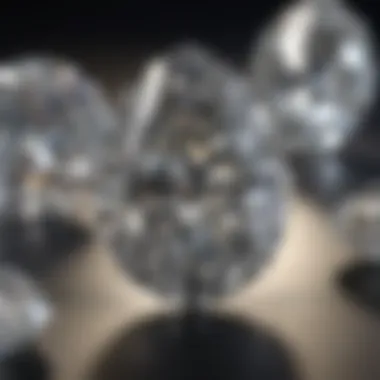
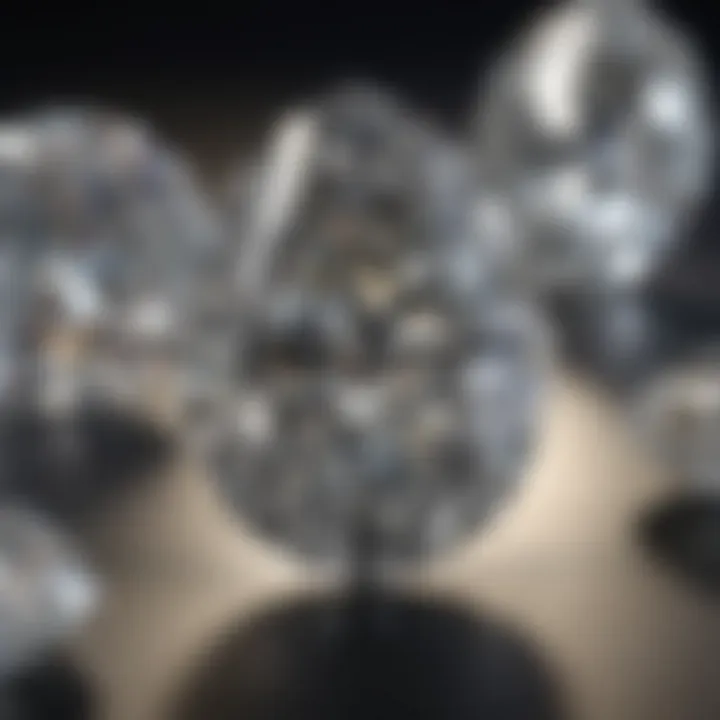
Cultural Significance of Marquise Cut Diamonds
The cultural significance of marquise cut diamonds extends far beyond their physical attributes. They carry a unique charm and story that resonates with people across various societies. This section unfolds the myriad ways in which marquise cut diamonds have been integrated into traditions and fashion, influencing perceptions and relationships around the world.
Symbolism in Engagement Rings
Engagement rings are often seen as a declaration of love and commitment. The marquise cut, with its elongated shape, symbolizes a desire for uniqueness. Its design evokes the image of a woman's body, celebrating femininity and allure. The elegant, tapering points of the marquise cut also give the illusion of longer fingers, making it appealing for many who seek to choose a ring that subtly enhances beauty.
- In terms of symbolism, the marquise cut offers:
- A representation of love that is both timeless and distinct.
- The feeling of exclusivity, as this cut isn't as common as others, such as round diamonds.
- An elegant choice that tends to stand out, drawing admiration.
Historically, the marquise cut has roots in French nobility. Legend has it that the shape was created in the 18th century for the Marquise de Pompadour, the mistress of King Louis XV. This association with aristocracy lends an air of sophistication and grandeur to any piece of jewelry.
Influence of Fashion and Celebrities
Fame often magnifies the allure of certain styles, and marquise cut diamonds have benefited from this effect. Over the decades, prominent figures have chosen marquise cuts for their engagement or statement pieces, helping to perpetuate its allure within popular culture.
- Noteworthy instances include:
- Elizabeth Taylor’s marquise diamond engagement ring, which not only showcased her unique style but also highlighted the cut's exquisite sparkle.
- Celebrities like Jennifer Lopez and Gabrielle Union have also sported marquise cut engagement rings, further embedding this choice in modern romance.
The marquise cut's association with celebrity status often leads to a trickle-down effect in fashion. When a well-known figure chooses this particular cut, it can spark trends and influence consumer choices. The elegance portrayed in these high-profile instances is what many aspire to emulate in their personal lives.
"A marquise diamond in an engagement ring esablishes a narrative — it's as if you're telling a story of love that stands out."
Through fashion magazines, social media buzz, and red-carpet appearances, marquise cut diamonds continue to make waves. Their lavish presentation captures attention, making them a go-to for those wanting to make a memorable statement.
In summary, the cultural significance of marquise cut diamonds is woven into the fabrics of eros, fashion influence, and historical legacy. Understanding this context enriches the appreciation of these stones, encouraging prospective buyers to see beyond the mere aesthetics and into the deeper meanings they can represent.
Considerations for Buying Marquise Cut Diamonds
When it comes to choosing marquise cut diamonds, understanding the nuances of the buying process is key. The marquise cut, with its distinctive elongated shape, offers a unique visual appeal that many find alluring. However, purchasing such a diamond involves several considerations that can affect both enjoyment and potential future value. It is not just about splurging on a brilliant gem; it’s about making an informed decision that aligns with personal taste and investment sensibilities.
Factors to Evaluate Before Purchase
Before making a purchase, buyers should consider several essential factors:
- Quality of Cut: The cut of a diamond influences both its beauty and sparkle. A well-cut marquise should display symmetrical proportions and a balanced outline. Examine whether the diamond’s facets contribute to an even distribution of light.
- Clarity: Inspect the internal and external blemishes of the stone. A higher clarity grade often equates to a more desirable gem, as fewer inclusions mean a clearer and more radiant appearance.
- Color: Marquise cut diamonds are typically valued for their colorlessness. However, subtle hints of color can sometimes enhance the visual appeal. Compare various color grades to find a stone that meets your aesthetic preferences.
- Carat Weight: Larger stones can exponentially increase in value. Yet, larger carat weights do not always guarantee the best visual impact. Sometimes, a smaller, well-proportioned stone appears more brilliant than a larger one with poor cut quality.
Additionally, consider your own lifestyle and how the diamond will be worn. Factors like metal allergies or the day-to-day wear on a ring can influence both choice and durability.
Differences in Pricing Across Carat Sizes
Pricing for marquise cut diamonds can vary significantly with carat weight. Larger diamonds tend to have an exponential price increase relative to their size due to their rarity. Here’s a breakdown:
- Under 1 Carat: Typically, these stones are more affordable and can be found in a range of qualities. A well-cut, high-clarity marquise under one carat remains alluring yet cost-effective.
- 1 to 2 Carats: This range sees a notable jump in price, as the demand for stones between one to two carats is often higher. The visual impact starts to make a significant statement during this phase.
- 2 to 3 Carats: As you enter this size, the cost elevates sharply. Many buyers often focus on the quality of the cut and clarity to justify this investment.
- Over 3 Carats: At this level, the diamonds become luxurious symbols of status and rarity. The interplay of market demand plays a crucial role here; unique specimens or those with incredible brilliance may reach astronomical prices.
Ultimately, understanding these differences can help buyers make educated decisions, ensuring they select a marquise cut diamond that fits within both a budget and aesthetic aims.
"Invest wisely in diamonds, evaluate not just the beauty but the underlying qualities that enhance its value."
Investment Potential of Marquise Cut Diamonds
The investment potential of marquise cut diamonds represents a fascinating intersection of aesthetic appreciation and financial savvy. For gemstone enthusiasts and investors alike, understanding this potential is crucial in making informed decisions regarding purchases and holdings. Marquise cut diamonds, with their unique silhouette, not only captivate the eye but can also serve as a significant financial asset.
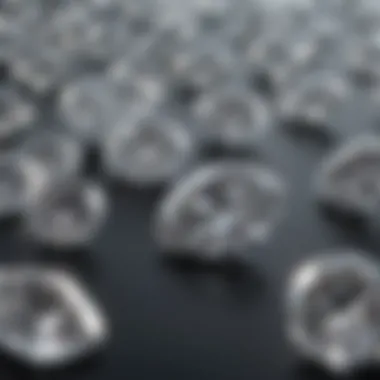

When considering marquise diamonds as an investment, several factors come into play. The diamond market can be volatile and variables like economic conditions, supply chains, and consumer preferences can affect prices. Consequently, potential buyers must stay informed about market fluctuations to navigate this landscape effectively.
Market Fluctuations
Market fluctuations in diamond prices can be as unpredictable as trying to catch smoke with your bare hands. Various elements contribute to these ups and downs. For instance, changes in consumer demand, influenced by trends from luminaries in the fashion world, can lead to rapid shifts in value.
Additionally, there's the global economic climate to consider. For example, during a robust economy, luxury items like diamonds often see enhanced demand, subsequently pushing prices higher. Conversely, economic downturns can lead to decreased sales, sending prices tumbling. Understanding these dynamics can give investors an edge in anticipating when to buy or sell.
Moreover, marquise cut diamonds' unique shape can sometimes make them more sensitive to market trends compared to more popular cuts like round or princess. Their distinctive appeal may limit demand to a more niche audience, which can affect liquidity in uncertain times.
"In the diamond investment world, patience really is a virtue. The market can have its ebbs and flows, but seasoned investors know to ride the waves instead of swimming against the current."
Long-Term Value Retention
Long-term value retention is another crucial aspect to consider when investing in marquise cut diamonds. Unlike other luxury items that may depreciate over time, high-quality diamonds often maintain or even appreciate in value, especially if they possess exceptional characteristics.
Marquise diamonds, with their striking appearance and historical significance, can hold their value remarkably well. Buyers typically look for diamonds that demonstrate outstanding qualities like clarity, color, and the craftsmanship of the cut—a hallmark of how well the diamond was fashioned. A marquise that hits the sweet spot on these attributes can be a wise investment, potentially retaining its value better than less sought-after shapes.
Moreover, as diamond scarcity increases, particularly for larger carat weights, the proposition of owning a marquise cut can become even more appealing. This limited availability can serve as a hedge against inflation and market downturns, allowing investments in marquise diamonds to stand the test of time.
To sum up, understanding market fluctuations and long-term value retention provides a clearer view for potential investors in marquise cut diamonds. The unique charm of this diamond shape, coupled with wise market strategies, can lead to not just a stunning piece of jewelry but also a substantial investment for the future.
Caring for Marquise Cut Diamonds
When it comes to marquise cut diamonds, understanding how to care for them plays a crucial role in maintaining their beauty and value. These diamonds, with their distinctive elongated shape and brilliant facets, are not just a treat for the eyes but also an investment worth safeguarding. Just like any valuable possession, proper maintenance can significantly extend their lifespan, keeping them shining for generations.
Cleaning and Maintenance Routines
Cleaning a marquise cut diamond is essential not just for aesthetic reasons but also for practical ones. Over time, dirt, oils from the skin, and environmental pollutants can dull the diamond’s brilliance. Here are some tailored tips to keep your marquise diamond looking its best:
- Regular Cleaning: It’s advisable to clean the diamond at least every few weeks. Warm, soapy water—using mild dish soap—works wonders. Soak the diamond for about 20-30 minutes, then use a soft brush, like a toothbrush, to gently scrub the intricate facets.
- Ultrasonic Cleaners: These devices can be very effective, especially for deeper cleaning. However, always check if your diamond is securely set before using an ultrasonic cleaner. Some settings might not withstand the vibration.
- Avoid Harsh Chemicals: Certain cleaners, especially those containing ammonia or bleach, can damage your diamond’s setting and its lustre. Stick to gentle formulas to keep both the diamond and its mount safe.
- Professional Cleaning: At least once a year, have the diamond inspected and cleaned by a professional jeweler. They can check for any loose stones and perform a deeper clean, ensuring that the diamond’s sparkle is maintained.
"Just a little care can keep your marquise diamond dazzeling like it's brand new."
Storage Recommendations
When it comes to storing a marquise cut diamond, the way it’s kept can greatly impact its condition. Here are several key recommendations:
- Separate from Other Jewelry: Marquise cut diamonds can be prone to scratches and abrasions if stored with other gemstones. Use a soft pouch or a lined jewelry box to avoid any direct contact with other pieces.
- Keep Away from Heat: High temperatures can affect both the diamond and metal settings. Try to store your diamond in a cool, dry place away from heat sources, such as radiators or sunlight.
- Use Anti-tarnish Cloths: If your diamond is set in a white gold or sterling silver, tarnishing can be an issue. Wrapping jewelry in anti-tarnish cloths can help prevent discoloration and keep settings bright.
- Consider a Safe: For high-value diamonds, it’s worthwhile to invest in a safe, protecting it from theft or damage. Choose one that is secure and fits your storage needs.
Taking the time to clean and care for your marquise cut diamonds can yield dividends in their appearance and longevity. And by observing correct storage practices, you’re not just safeguarding a piece of jewelry—you’re maintaining a valuable asset that may appreciate over time.
Culmination: The Enduring Appeal of Marquise Cut Diamonds
The allure of marquise cut diamonds lies not just in their distinct shape, but also in their intricate connection to history, fashion, and status. This section synthesizes the valuable insights presented in the article, emphasizing the significance of marquise cut diamonds for both collectors and consumers. The unique charm of these diamonds provides a compelling narrative that ties together their aesthetic qualities and investment potential.
Recap of Marquise Diamond Value
Marquise cut diamonds occupy a unique niche in the gemstone market. Recognized for their striking silhouette, they embody elegance and sophistication. When evaluating their market value, it’s essential to consider the four Cs: Cut, Clarity, Color, and Carat Weight. Each factor plays a vital role in determining a diamond’s overall quality and, consequently, its market appeal. Additionally, the rarity of well-crafted marquise diamonds can enhance their desirability, making them a cherished choice for many.
"In the realm of diamonds, marquise cuts captivate with their beauty, often reflecting personal stories and historic significance."
The trends in market demand show fluctuations, with marquise cut diamonds often enjoying peaks in popularity during certain fashion cycles and events. It’s crucial for potential buyers to keep an eye on these trends, as they influence both resale value and investment returns.
Final Thoughts on Investment and Aesthetic Longevity
Considering investing in marquise cut diamonds involves assessing not only their aesthetic appeal but also their potential as a financial asset. Unlike other cuts, the versatility of the marquise allows them to stand out in various settings, from classic solitaire rings to intricate bridal sets. This adaptability can sustain their value over time, making them an attractive option for investors who appreciate both beauty and merit.
Furthermore, the lasting appeal of marquise cut diamonds transcends fleeting trends. Their rich history implies a continual interest from gemstone enthusiasts and collectors. As new generations seek unique pieces for personal adornment or investment, marquise cut diamonds consistently emerge as a timeless choice.
In summary, the enduring appeal of marquise cut diamonds, with their intersection of aesthetics and value, offers both beauty and significance. For those considering diving into the world of gemstones, marquise cuts present an exciting opportunity that combines history, elegance, and potential growth in value.







